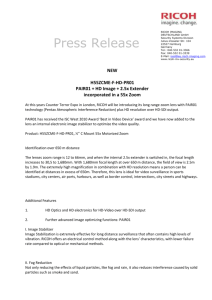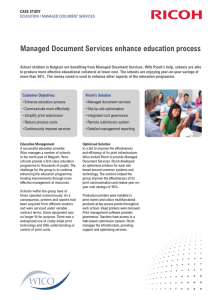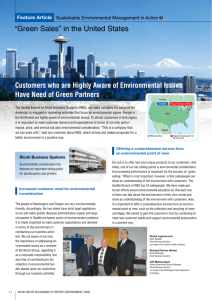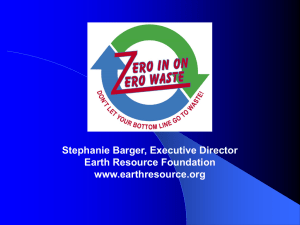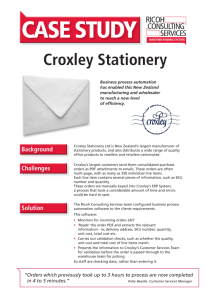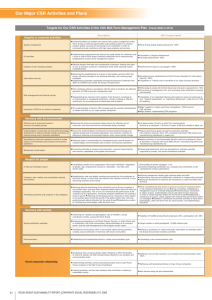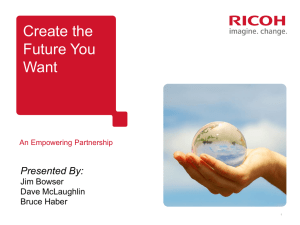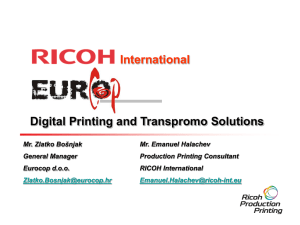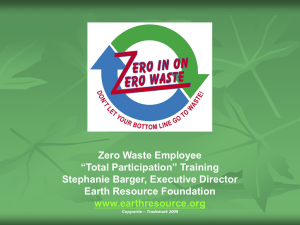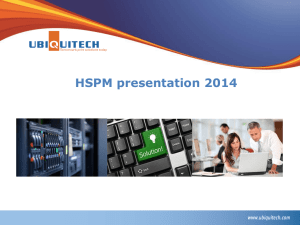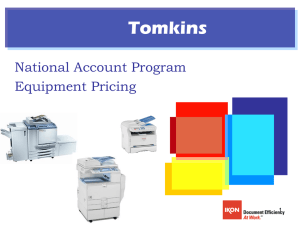Andy Whyle - Base Cities
advertisement
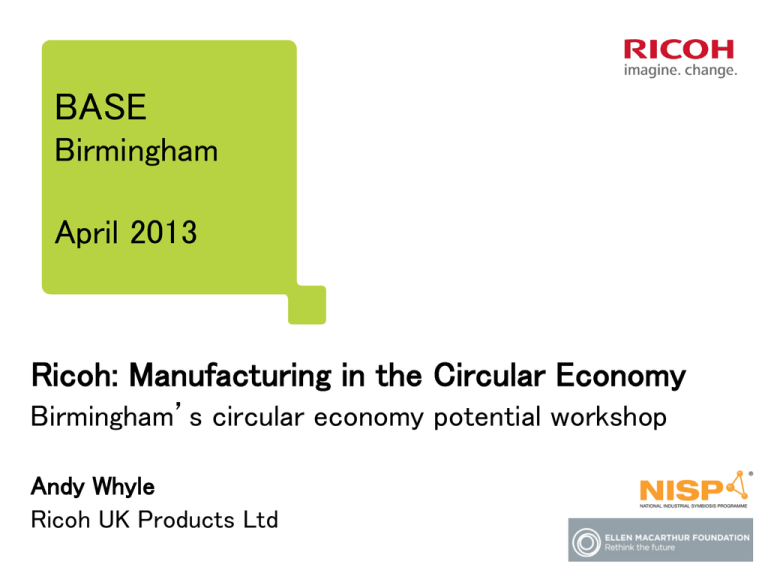
BASE Birmingham April 2013 Ricoh: Manufacturing in the Circular Economy Birmingham’s circular economy potential workshop Andy Whyle Ricoh UK Products Ltd Content Ricoh & Corporate Environmental Strategy Zero waste Remanufacturing Circular Economy Planet People Profit Ricoh Group Corporate Data Founded in 1936. Headquarters in Tokyo, Japan. £14 billion turnover Digital multifunction Office Automation equipment PC’s, servers, networking and software Optical equipment - cameras. Toner, inks and related supplies Cloud server systems 108,500 employees worldwide. Ricoh Global Manufacturing ■ Ricoh Electronics, Inc California & Georgia ■ Ricoh UK Products Ltd. (RPL) ■ Ricoh Industrie France S.A.S. UK France U.S.A China Thailand ■ Ricoh Components & Products (Shenzhen) Co., Ltd. ■ Shanghai Ricoh Digital Equipment Co., Ltd. ■ Ricoh Asia Industry (Shenzhen), Ltd. Ricoh Japan 14 Production Sites. ■ ■ Ricoh Manufacturing (Thailand), Ltd. Ricoh Telford - RPL Established in 1984 Based in Telford & Wellingborough 811 employees £386 million turnover Supplying European market place Product Range MFP Recycling MFP production Colour toner + configuration + Moulding Production Printers RPL 2 Cartridge Recycling RPL 3 RPL 1 B&W Toner Site Entrance Production Ricoh Group Standards Environmental Strategies 2002: Zero Waste: all Ricoh Group Manufacturing sites achieve Zero Waste to Landfill standard. 2005 Ricoh established the Year 2050 Long-Term Environmental Vision to reduce environmental impacts to oneeighth of year 2000 level (a “World 1st”) Ricoh’s objectives are to reduce the input of new resources by 25% by 2020 and by 87.5% by 2050 and to reduce the use of—or prepare alternative materials for—the major materials of products that are at high risk of depletion (e.g., crude oil, copper, and chromium) by 2050. Benchmarking Ricoh recognised as one of Top Global Corporations RPL •Energy Efficiency Accreditation Scheme (Top 5 UK) 2004 • BQF UK Gold Medal for Sustained Excellence 2009 • Environment Agency: Best private sector Finalist 2010 • Business Commitment to the Environment Premier Award 2011 • Benchmarking - leadership and being confident in sharing environmental best practice Environmental Action Committee Green Procurement: Suppliers to have environmental management systems Energy & Water Reduction: Reduction in CO2/Water Env. Action Committee Resource Conservation : Minimisation & Waste-2-Product Recycling of Products: Recycled machines, parts and cartridges, Customer satisfaction, Brand awareness and development Landfill Biodiversity: Conservation on and off site Strategic Summary Concept: Long term strategic approach with staged targets (Mid Term Plans) working to 2050, Approach: 3P’s, Eco-centric culture change with Techno-centric development, Result: Not optional activity - Sustainability embedded into management culture with performance targets (organisational and individual). Resource Conservation Zero Waste to Landfill Reducing Operational Impact 1 2 Ricoh Group's global environmental conservation: Keeping environmental impact within the self-recovery capabilities of the Earth Zero waste performance Waste v Turnover 400 Waste (tonnes) Turnover (£M) 350 2000 300 200 1000 £M 250 1500 tonnes Waste is now decoupled from Turnover 2500 150 100 500 50 0 0 2000 2001 2002 2003 2004 2005 2006 2007 2008 2009 2010 2011 Waste Generated / £M Turnover 25.0 350 Turnover (£M) 19.5 Linear (tonnes generated / £M) 15.0 300 250 13.4 200 10.0 10.0 8.1 8.0 150 7.9 6.3 6.1 6.3 6.6 4.8 5.0 4.5 100 50 0.0 0 2000 2001 2002 2003 2004 2005 2006 2007 2008 2009 2010 2011 £ 20.0 T/£M Tonnes of Waste per £Million turnover has improved by 77% 400 tonnes generated / £M Zero Waste Business benefit Zero Waste “Waste-2-Product” Profitability £140,000 £59k £120,000 Waste Streams £50k £100,000 Recycled Product £80,000 £60,000 £40,000 £20,000 £0 1999 2000 2001 2002 2003 2004 2005 2006 2007 2008 2009 2010 2011 2012 -£20,000 Disposal Cost Revenue -£40,000 Profit - £46k -£60,000 Product Waste Recycling Centre Resource Conservation Remanufacturing Reducing Operational Impact 1 2 Ricoh Group's global environmental conservation: Keeping environmental impact within the self-recovery capabilities of the Earth Resource Security Expected Life of Key Resource Materials Iron Lime Timber (pulp) Aluminium Chrome Nickel Molybdenum Copper Silica stone Fluorite Lithium Cobalt Oil Gold Silver Palladium Magnesium Bismuth Beryllium Antimony Zinc Indium Lead (c.f.) Mercury (c.f.) 600 500 400 300 200 100 0 (“Peakonomics”) 50 Years availability Source:Environmental information technology centre FY07 Sustainability Indicators Commodity prices ↑ by 147% since 2000 33 commodities lost 70% of their value over the course of the 20th century, but in the last 10 years their prices have, on average, tripled Jae Mather 2013 Manufacturing Today The sustainable ideal is a balanced sustainable (3Ps) approach Planet Most of today’s product tends towards 1st life/ People Profit single use (profit centric) Profit Sustainable design is increasing, but not mainstream Ricoh reacts to the market conflict of “1st Life vs. Sustainable Customer Demand” through Robust reverse logistics Life cycle (Comet Circle) drive towards retention of assets Ricoh’s role is to learn, and move towards Resource Conservation and the Circular Economy N -4 N N -1 N -2 N -3 N -5 N -6 Eco-Line products Diversification: UK Remanufactured Products Remanufacturing Process “Remanufactured” machines (Manufacture assembly, disassembly and end of life - MADE BS8887 part2) Striped to chassis: All mortality parts replaced /All panels sprayed All firmware / software modifications fitted Completely Re-branded and sold as new line Quality Control: inspected assured and warranted the same as new products Extending the life cycle, reducing environmental impact Life Cycle: Comet Circle deployment Materials Manf. Parts Manf. Product Manf. Operating Company Customer Materials Supplier Secondary User of Materials Maintenance Recovery Parts Recovery Materials Recovery Green Centre Raw material recovery Incineration with Energy Recovery Recycling Centre Material Separation Circular Economy Final Disposal Circular Economy: Remanufacturing issues R&D: Remanufactured Product requires investigation into life-cycle of parts (mandatory & non-mandatory replacements) Incoming QC of returning parts: assessing next life capability (reuse or recycle) Production process : Operator skill levels retained & maintained from original production. QC trace-ability: re-identification of product to maintain quality standards. Reverse Logistics: customer engagement, collection methods, cost effective logistics, symbiotic partnership development (CE 100) Circular Economy: Life Cycle Analysis Raw material Manufacture Raw material & Manufacture 32.9% Customer usage Disposal Sales 6.9% Customer 65.4% Environmental Impact of Remanufacturing 38% reduction 0.02% Recycling -5.2% Recycle & disposal Summary - Circular Economy Concept: develop business strategy to maintain materials for productivity – – – – – – Long term approach (2050 Plan) Improves Waste hierarchy compliance Reverse logistics & customer engagement Life Cycle - Comet Circle deployment Diversification of operation (remanufacturing) Work with like minded organisations (NISP / CE 100) Result: Reduced environmental impact of operation, extended life cycle of materials, resulting in diversifying Ricoh’s operation to maintain future business continuity (Sustainability). Sustainability = Business Continuity
